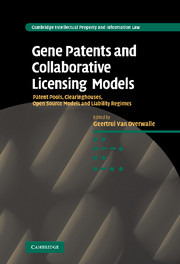 Gene Patents and Collaborative Licensing Models
Gene Patents and Collaborative Licensing Models Book contents
- Frontmatter
- Contents
- List of contributors
- Preface
- Foreword: Jean-Jacques Cassiman
- List of abbreviations
- Part I Patent pools
- Part II Clearinghouses
- Part III Open source models
- Part IV Liability regimes
- Part V Different perspectives
- 20 Gene patents: from discovery to invention. A geneticist's view
- 21 ‘Patent tsunami’ in the field of genetic diagnostics. A patent practitioner's view
- 22 Gene patents and clearing models. Some comments from a competition law perspective
- 23 Access to genetic patents and clearing models. An economic perspective
- 24 The role of law, institutions and governance in facilitating access to the scientific research commons. A philosopher's perspective
- Part VI Summary and concluding analysis
- Index
- Titles in the series
20 - Gene patents: from discovery to invention. A geneticist's view
from Part V - Different perspectives
Published online by Cambridge University Press: 14 January 2010
- Frontmatter
- Contents
- List of contributors
- Preface
- Foreword: Jean-Jacques Cassiman
- List of abbreviations
- Part I Patent pools
- Part II Clearinghouses
- Part III Open source models
- Part IV Liability regimes
- Part V Different perspectives
- 20 Gene patents: from discovery to invention. A geneticist's view
- 21 ‘Patent tsunami’ in the field of genetic diagnostics. A patent practitioner's view
- 22 Gene patents and clearing models. Some comments from a competition law perspective
- 23 Access to genetic patents and clearing models. An economic perspective
- 24 The role of law, institutions and governance in facilitating access to the scientific research commons. A philosopher's perspective
- Part VI Summary and concluding analysis
- Index
- Titles in the series
Summary
Introduction
At the start of the 1990s, gene patents were already well engrained in the field of biochemistry and cell biology. Typically, they were targeted at specific, well-described and credible applications, ranging from receptor proteins useful for drug entry to sweetening proteins to replace sugar. The advent of gene cloning per se, in the preceding two decades, had not made an impact as a dramatic departure from existing patent practice. The major onslaught of large-scale, high-throughput automated sequencing, however, precipitated an intense debate on intellectual property (IP) issues, associated with the identification of our genetic heritage. As early as 1991, HUGO organised an expert workshop on this topic in Munich. This led to a first ‘HUGO position statement on cDNA patents’ (1992), noting that patenting DNA segments of unknown function was unjustified as these were mere discoveries, and that this practice would stifle upstream research. It was proposed to restrict patents to genes or other DNA elements of which the function was elucidated.
The issue of gene patents materialised in earnest in the genome community in 1992, when J. Craig Venter, then employed by the US National Institute of Health (NIH), after internal NIH consideration and stimulated by its director Bernadine Healey, submitted patent applications for 2,000 so-called ESTs (expressed sequence tags, short randomly cloned cDNA segments), on the basis that if they would not be protected this might cause missed future commercialisation possibilities. The scientific community reacted with profound and widespread dismay.
- Type
- Chapter
- Information
- Gene Patents and Collaborative Licensing ModelsPatent Pools, Clearinghouses, Open Source Models and Liability Regimes, pp. 311 - 330Publisher: Cambridge University PressPrint publication year: 2009
- 1
- Cited by


